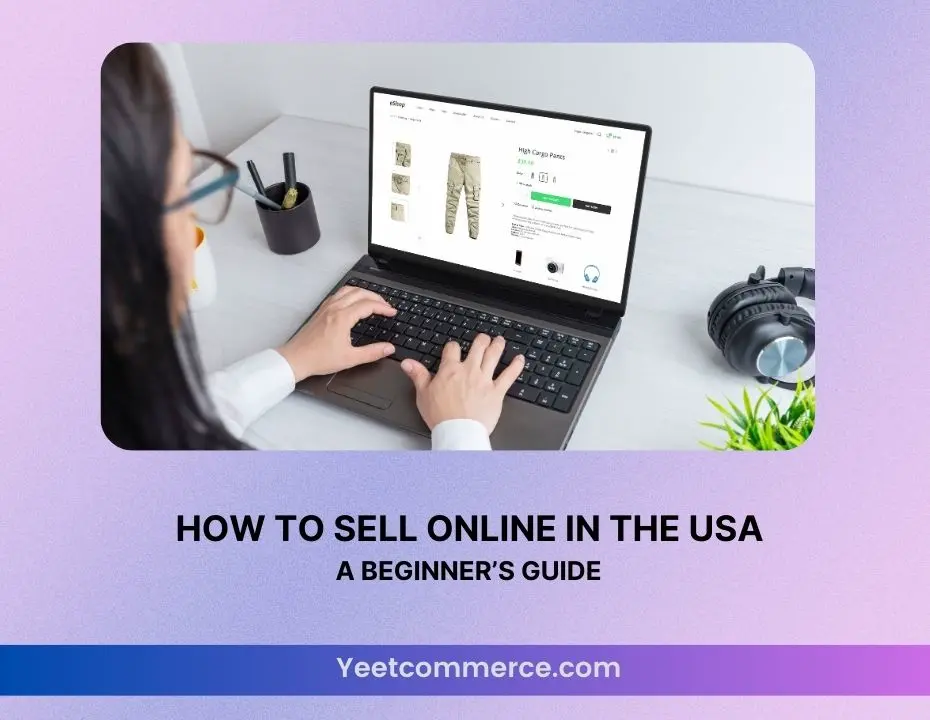The digital marketplace in the United States offers an unparalleled opportunity for entrepreneurs and businesses of all sizes to reach a vast customer base. Whether you’re a seasoned seller looking to expand your online presence or a complete beginner with a great product idea, understanding the fundamentals of e-commerce is essential. This guide, “How to Sell Online in the USA: A Beginner’s Guide,” is designed to demystify the process, providing a clear and actionable roadmap to launching and growing your online business.
Understanding U.S. Online Shopping Trends
Selling online in the USA means keeping up with evolving shopping trends. Consumers today have higher expectations than ever, demanding convenience, security, and personalization. If your store doesn’t meet these expectations, customers will bounce faster than you can say “checkout.” A report by eMarketer estimates that U.S. eCommerce sales will surpass $1.3 trillion by 2025, proving that the online shopping boom isn’t slowing down. To stay ahead, you need to understand what buyers expect and how to deliver it.
1. Fast and Free Shipping Wins Customers
Amazon has spoiled U.S. consumers with lightning-fast shipping, and now they expect the same from every online store. According to a survey by Baymard Institute, 48% of shoppers abandon their carts due to high extra costs, including shipping fees. Free shipping is no longer a perk—it’s a necessity. If you can’t offer free shipping outright, consider rolling the cost into product prices or providing free shipping on orders over a certain amount. As Jeff Bezos famously said, “We see customers as invited guests to a party, and we are the hosts.” Treat your customers well, and they’ll keep coming back.
2. Mobile Shopping is King
If your online store isn’t mobile-friendly, you’re leaving money on the table. Over 73% of U.S. eCommerce sales come from mobile devices, according to Insider Intelligence. Buyers want smooth navigation, quick load times, and an easy checkout process. Responsive design, one-click payments, and mobile-friendly product pages should be at the top of your priority list. Google research also shows that 53% of users abandon a mobile site if it takes longer than three seconds to load. So, make sure your store runs fast on all devices!
3. Personalization Creates Loyal Shoppers
U.S. consumers love personalized shopping experiences. In fact, a study by McKinsey found that 71% of buyers expect personalization, and 76% get frustrated when it’s not offered. From personalized product recommendations to email marketing tailored to past purchases, the more relevant your offers, the more likely customers will convert. AI-driven eCommerce tools can help you analyze customer behavior and suggest the right products at the right time.
4. Trust and Security Matter More Than Ever
With cyber threats on the rise, U.S. shoppers are more cautious about where they enter their credit card details. The Federal Trade Commission (FTC) reported that online fraud losses reached $8.8 billion in 2022. If your store lacks proper security features like SSL certificates, secure payment gateways, and transparent privacy policies, customers won’t trust you. Displaying trust badges, offering multiple secure payment methods, and having a clear return policy can reassure hesitant buyers.
5. Social Commerce and Influencer Marketing Drive Sales
Social media isn’t just for scrolling—it’s a powerful sales channel. A recent report from HubSpot found that 30% of U.S. consumers purchase directly through social media platforms like Instagram, Facebook, and TikTok. Influencers also play a significant role in shaping buying decisions. Partnering with micro-influencers in your niche can help you build trust and drive sales without spending a fortune on ads. Social proof, like customer reviews and user-generated content, can also boost your credibility.
How to Find a Profitable Niche
Choosing the right niche can make or break your online business. A profitable niche balances market demand, competition, and profitability. Here’s how you can find yours:
1. Identify Market Demand
Start by researching trending products and industries. Tools like Google Trends, Amazon Best Sellers, and social media platforms can help you spot growing trends. Look for niches with a steady or rising interest rather than short-lived fads.
2. Analyze Competition
A niche with no competition is a red flag—it likely means there’s no demand. However, too much competition can make it difficult to stand out. Research your competitors to see what they’re offering and identify gaps you can fill.
3. Consider Profit Margins
Low-cost, high-demand products may seem attractive, but if profit margins are razor-thin, your business will struggle. Calculate costs, including sourcing, shipping, and marketing, to ensure you can make a sustainable profit.
4. Validate Your Idea
Before committing to a niche, test it. Use surveys, pre-orders, or small-scale ad campaigns to gauge interest. Selling a few units before investing heavily can save you time and money.
How to Register a Business in the USA
Selling online in the USA involves more than just having a great product and a well-designed website. You must also comply with legal requirements to avoid fines, protect your assets, and ensure smooth operations. Here’s a detailed breakdown of the steps you need to take:
1. Choose the Right Business Structure
Before you start selling, you need to determine the legal structure of your business. This decision affects your taxes, liability, and administrative responsibilities. The most common options for online sellers include:
- Sole Proprietorship – The simplest and most affordable option, but it offers no personal liability protection. If your business faces debts or legal issues, your personal assets could be at risk.
- Limited Liability Company (LLC) – A popular choice for small business owners as it separates personal and business assets, reducing liability risks. It also offers tax flexibility, allowing you to be taxed as a sole proprietor, partnership, or corporation.
- Corporation (C-Corp or S-Corp) – Best suited for larger businesses or those seeking investment. Corporations offer strong liability protection but come with complex tax and regulatory requirements.
2. Register Your Business
Once you’ve chosen your business structure, you may need to register your business at the state and federal levels:
- State Registration: If forming an LLC or corporation, you must register with your state’s Secretary of State office. Each state has different filing fees and requirements.
- Federal Employer Identification Number (EIN): Most businesses need an EIN from the Internal Revenue Service (IRS). This unique number is used for tax purposes, hiring employees, and opening a business bank account. You can apply for an EIN online for free through the IRS website.
- Doing Business As (DBA) Name: If you plan to operate under a name different from your legal business name, you may need to file a DBA with your state or county.
3. Understand and Manage Taxes
Online sellers in the USA must comply with federal, state, and sometimes local tax laws. Here’s what to consider:
- Sales Tax: Sales tax rates and rules vary by state. Some states require online sellers to collect sales tax based on where the buyer is located. You may need to register for a sales tax permit with your state’s tax authority.
- Income Tax: If you’re self-employed, you must report your business income on your personal tax return and make estimated quarterly tax payments to the IRS.
- Tax Deductions: Business expenses such as website hosting, advertising, and shipping costs can be deducted to lower your taxable income. Using tax software or consulting a tax professional can help ensure compliance and maximize deductions.
4. Obtain Necessary Business Licenses and Permits
Depending on your location and industry, you may need specific licenses or permits to operate legally:
- State Business Licenses: Some states require general business licenses for all companies. Check with your state’s business regulatory agency.
- Industry-Specific Permits: If you sell regulated products like dietary supplements, cosmetics, or electronics, you may need approvals from agencies such as the Food and Drug Administration (FDA) or the Federal Communications Commission (FCC).
- Home-Based Business Permits: If you run your business from home, your city or county may require a home occupation permit.
5. Comply with FTC and Consumer Protection Regulations
The Federal Trade Commission (FTC) enforces consumer protection laws that online businesses must follow. Key requirements include:
- Truth in Advertising: All product descriptions, pricing, and promotional materials must be honest and not misleading. False claims can lead to legal issues.
- Transparent Return & Refund Policies: Clearly state your return, refund, and exchange policies on your website to avoid disputes.
- Email Marketing Compliance (CAN-SPAM Act): If you send marketing emails, you must include an option for recipients to unsubscribe and avoid deceptive subject lines.
Choosing the Right eCommerce Platform
Selling online in the USA starts with a crucial decision: choosing the right eCommerce platform. The right platform ensures a seamless selling experience, from listing products to handling payments and shipping. With countless options available, you need to focus on features that make selling smoother, not harder. According to Statista, eCommerce sales in the USA are projected to reach $1.3 trillion by 2025, meaning there’s never been a better time to dive in!
1. User-Friendly Interface and Customization Options
Your eCommerce platform should be easy to use, even if you’re not a tech wizard. Deciding where to sell your products is crucial. You can sell through established marketplaces like Amazon, Etsy, and eBay or build your own website. Each option has pros and cons.. Platforms like BigCommerce, and YeetCommerce offer drag-and-drop tools, making website setup a breeze. Customization options are equally important because your store should reflect your brand, not look like every other online shop. A study by Sweor found that 75% of consumers judge a company’s credibility based on its website design, so investing in a customizable platform is a must.
2. Mobile Optimization and Speed Performance
Over 73% of eCommerce sales in the USA come from mobile devices, according to Insider Intelligence. If your website isn’t mobile-friendly, you’re losing a massive chunk of potential buyers. Platforms like WooCommerce and Wix ensure your store looks and functions great on all screen sizes. Speed is another deal-breaker—Google research shows that a one-second delay in page load time can drop conversions by 7%. So, pick a platform that prioritizes fast-loading pages!
3. Secure Payment Processing and Multiple Payment Options
Trust is everything in online selling, and nothing builds trust faster than secure payment processing. Shoppers want payment options that suit their preferences, whether it’s credit cards, PayPal, Apple Pay, or Buy Now, Pay Later services. A report by Baymard Institute states that 17% of cart abandonments happen due to a lack of preferred payment methods. Make sure your eCommerce platform supports multiple secure payment gateways to keep buyers happy.
4. Built-in SEO and Marketing Features
You can’t sell online in the USA if customers can’t find your store. That’s where SEO (Search Engine Optimization) comes in. Platforms like YeetCommerce have built-in SEO tools that help your store rank higher on Google. Features like customizable meta tags, URL structures, and blog integration can boost organic traffic. Marketing tools such as email automation and abandoned cart recovery also play a key role in driving sales. As digital marketing expert Neil Patel says, “Don’t optimize for conversions, optimize for revenue.”
5. Inventory Management and Scalability
Your store should be able to grow with your business. If you start with 10 products and later expand to 1,000, your platform should handle that with ease. Look for platforms with automated inventory tracking, low-stock alerts, and seamless integration with suppliers. According to Oberlo, 43% of small businesses in the USA struggle with inventory management, so choosing a platform that simplifies this process can save you time and stress.
Payment & Shipping Considerations
Selling online in the USA requires more than just great products—you need secure payments and reliable shipping to keep customers happy. Shoppers want a seamless experience, from checkout to delivery. A Statista report shows that digital payments in the U.S. will surpass $2.4 trillion by 2025, proving how crucial smooth transactions are for eCommerce success. Meanwhile, 87% of online shoppers say shipping speed impacts their decision to buy. Let’s break down the essentials of setting up secure payments and reliable shipping.
1. Offering Secure and Convenient Payment Methods
Your checkout page can make or break a sale. If customers don’t find their preferred payment option, they’ll likely abandon their cart. According to Baymard Institute, the average cart abandonment rate is 69.99%, with complicated checkout processes being a top reason. Offering a variety of payment options—including credit cards, PayPal, Apple Pay, and Buy Now, Pay Later (BNPL) services—keeps buyers satisfied. Also, integrating fraud protection tools like SSL encryption and PCI compliance ensures secure transactions. As cybersecurity expert Bruce Schneier puts it, “Security is not a product, but a process.” Prioritize it, and customers will trust your store.
2. Choosing the Right Shipping Strategy
Shipping can be a deal-breaker for many customers. A report by Shippo found that 62% of shoppers expect free shipping, while 77% have abandoned purchases due to unsatisfactory delivery options. To sell online in the USA successfully, consider offering multiple shipping choices, such as standard, express, and same-day delivery. Partnering with reliable carriers like USPS, FedEx, and UPS ensures timely deliveries. If you’re using third-party fulfillment services, ensure they provide tracking and return management to keep customers informed.
3. Optimizing Your Shipping Costs
Shipping costs can eat into your profits if you don’t plan carefully. Many sellers use a combination of free shipping, flat-rate shipping, and weight-based pricing to balance affordability and profitability. Shopify reports that 39% of businesses that offer free shipping see higher conversion rates. One strategy is to include shipping costs in your product price so customers feel like they’re getting a deal. Offering local pickup and regional shipping discounts can also attract more buyers.
4. Handling Returns Efficiently
Returns are inevitable, but a hassle-free return policy can boost customer confidence. According to Narvar, 95% of shoppers say a positive return experience encourages them to buy again. Clearly stating your return policy on your website, providing prepaid return labels, and offering fast refunds can set you apart from competitors. Using automated return systems can also simplify the process for both you and your customers.
Marketing Strategies for U.S. Audiences
Selling online in the USA is competitive, but the right marketing strategies can help you attract and retain American customers. According to eMarketer, U.S. eCommerce sales are projected to reach $1.6 trillion by 2027, making it essential to stand out. Understanding buyer preferences, leveraging digital marketing, and building brand loyalty will set your store up for success. Let’s explore the best ways to connect with and keep U.S. shoppers engaged.
1. Leveraging Social Media & Influencer Marketing
Social media is a goldmine for eCommerce sellers in the USA. With over 302 million active users, platforms like Instagram, TikTok, and Facebook offer massive opportunities for brand exposure. Studies show that 49% of U.S. consumers rely on influencer recommendations before purchasing a product. Collaborating with influencers and running targeted social media ads can drive traffic to your store. As marketing expert Seth Godin says, “People do not buy goods and services. They buy relations, stories, and magic.” Creating engaging content and fostering genuine connections will help you build a loyal customer base.
2. Optimizing for SEO and Localized Advertising
If you want to sell online in the USA successfully, search engine optimization (SEO) should be a priority. Around 46% of all Google searches are looking for local information, meaning U.S. shoppers often seek region-specific products. Using localized keywords, optimizing product pages, and setting up Google My Business can increase your visibility. Additionally, running geo-targeted ads on Google and social platforms ensures you reach the right audience. Paid advertising, when done right, can offer a return on investment (ROI) of $2 for every $1 spent.
3. Offering Personalization & Customer Engagement
Americans love personalized shopping experiences. A study by McKinsey found that 71% of consumers expect personalized interactions, and 76% get frustrated when they don’t get them. Using AI-driven tools to recommend products, sending personalized emails, and engaging with customers through chat support can significantly boost conversions. Loyalty programs, referral incentives, and interactive content also keep customers engaged.
4. Running Seasonal Promotions & Email Campaigns
Seasonal sales play a huge role in the U.S. market. Events like Black Friday, Cyber Monday, and back-to-school shopping drive massive sales spikes. In 2023, Black Friday alone saw $9.8 billion in online sales. Running time-sensitive promotions and email marketing campaigns can drive urgency and boost sales. Offering discounts, free shipping, or exclusive deals to repeat customers enhances brand loyalty.
Final Thought
Selling online in the USA requires a strategic approach that includes social media engagement, localized SEO, secure payment options, and efficient shipping. Providing a seamless shopping experience with multiple payment methods and reliable shipping builds trust and enhances customer satisfaction. Choosing the right eCommerce platform is equally important—look for one that is user-friendly, mobile-optimized, and packed with SEO and marketing tools to drive sales.
To succeed in the competitive U.S. market, you must also meet buyer expectations by offering fast shipping, personalization, security, and social commerce integration. Staying ahead of these trends ensures a shopping experience that attracts and retains loyal customers. By leveraging digital tools and adapting to market changes, you can build a strong online presence, boost conversions, and create lasting customer relationships.


















